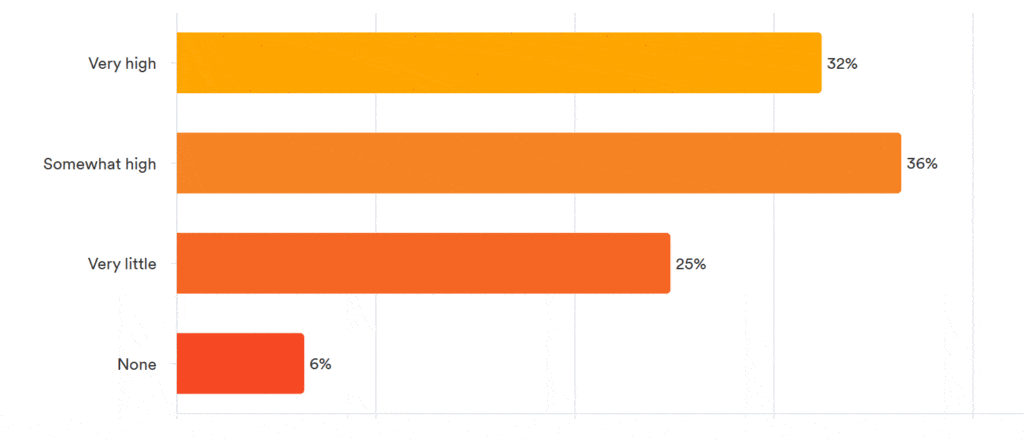According to the August LANDTHINK Pulse results, 36% of our audience indicated that they would give SOMEWHAT HIGH consideration to estimated timber value when buying large tracts of recreational land, followed closely by 32% who said they would give VERY HIGH consideration to estimated timber value when buying recreational land. Recreational land is a versatile land type that is purchased primarily for enjoyment and leisure, such as camping, hunting, fishing, or simply providing the perfect setting for outdoor adventures and peaceful retreats. The allure of recreational land is undeniable and purchasing it can be a game-changer. It’s not just about owning property; buying recreational land can also be an astute investment move. It is an asset that grows over time – only with added perks.
Last month, the August Pulse asked: When buying large recreational tracts, how much consideration do you give to the estimated value of the timber?

Recreational land offers unique opportunities for both financial returns and personal enjoyment. Unlike residential or commercial properties, recreational land offers diverse income streams. This can include timber harvesting, leasing for hunting or fishing, agricultural activities, and potential future development.
Timber value on recreational land contributes to its investment potential and is a significant factor that goes into the sales price. This is where a land professional will be very beneficial. They will walk you through the all the factors that go into the sales price and help you ask the right questions. Timber rights and property rights can be in the hands of two separate people. First, you should ensure that timber rights are sold along with the land. If there are mature stands on the property, that’s good news because it can likely be harvested in the near future. A harvest like this can help pay your property taxes for years, cover maintenance costs, or go toward upgrades and improvements. Even better—this doesn’t mean clear-cutting. The land management practice of selective harvesting, can help property owners maintain healthy, diverse woods for future generations.
If the estimated timber value on a recreational land tract you are considering is important to you, you need some realistic idea of how much potential there is for future timber sales. Otherwise, you risk overpaying for the tract and losing money from future sales. Timber value refers to the monetary worth of your standing trees, based on various factors including species, size, and quality. Knowing this value is important for landbuyers because it directly impacts financial decisions regarding land use and management.
If revenue generation is your goal, then promptly harvesting high-value timber may be best in order to capitalize on current market prices. If creating a deer-attracting ecosystem is your priority, you might opt to selectively harvest specific trees. Knowing the timber value aids in balancing economic gains with sustainable forestry practices.
The first step in valuing your timber is to know what you have. You need to conduct a timber inventory or a timber cruise, which is a systematic measurement of the trees on your land. A timber inventory will provide information such as the number, size, species, and quality of trees, as well as the volume and weight of timber. A timber inventory can be done by yourself, or by hiring a professional forester. The value is determined from prices received for timber from recently completed timber harvests. These numbers are then condensed into a report.
Here are some of the elements that influence timber prices and value:
Tree Species: Different tree species have different values; hardwoods like oak and walnut often command higher prices than softwoods like pine, red maple or sweet gum.
Timber Quality and Grade: A timber stand’s grade and quality have a big impact on its value. Superior appearance and fewer flaws are characteristics of higher-grade lumber, which also fetches premium prices. Experts in tree appraisal assess straightness, knots, and general health to assign a grade. While lower-grade wood is utilized for general applications, higher-grade wood is desired for furniture, moldings, and decorative purposes.
Market Conditions: Supply and demand determine timber pricing, with mill competition and local market dynamics playing a significant role. Construction activity, furniture manufacturing, and other wood-related industries influence the demand for specific tree species.
Accessibility and Costs: The price of timber can be greatly influenced by its availability and supply in your area. The proximity of your timber stand to local markets and mills can also influence its value. The cost of locally sourced wood species may be less than that of uncommon or imported types. Additionally, factors like sustainability concerns, logging regulations, and accessibility can affect the supply of certain species. When demand is high and supply is limited, the value of your standing timber may increase.
Economic Conditions: Timber prices can be impacted by economic factors like inflation, interest rates, and currency movements. Construction may slow down during recessions, which would lower demand for lumber and possibly lower your timber value. On the other hand, a strong economy with thriving manufacturing and building industries may cause timber prices to rise.
Recreational land purchasers frequently lack the knowledge necessary to evaluate the worth and quality of timber when making purchases. However, as most recreational tracts will include some timber, it’s crucial to ascertain up front how much timber matters to you as a buyer.
If you’re considering making a substantial investment like the purchase of a large recreational land tract, obtaining a ballpark estimate of the value of timber on the land is important. Even if the primary goal isn’t timber harvesting, a quality timber stand represents a potential financial asset and can enhance the property’s overall value and quality for wildlife.
Do you have a suggestion for next month’s Pulse question? Submit your question and we might choose yours!
This content may not be used or reproduced in any manner whatsoever, in part or in whole, without written permission of LANDTHINK. Use of this content without permission is a violation of federal copyright law. The articles, posts, comments, opinions and information provided by LANDTHINK are for informational and research purposes only and DOES NOT substitute or coincide with the advice of an attorney, accountant, real estate broker or any other licensed real estate professional. LANDTHINK strongly advises visitors and readers to seek their own professional guidance and advice related to buying, investing in or selling real estate.










Add Comment